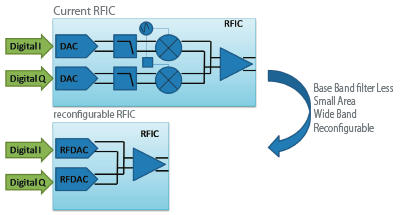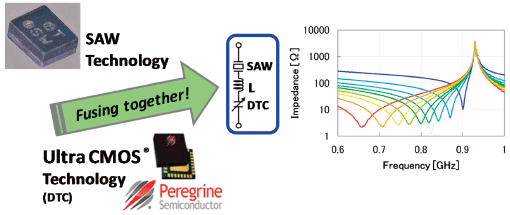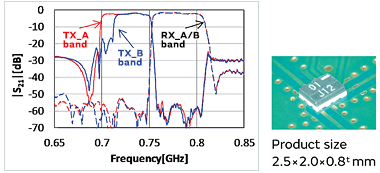The Proactive Development of Software Defined Radio Modules That Facilitate Adaptation to Future Communication Methods
Present high-functionality smartphones are adapted for more than six different kinds of communication methods and equipped with more than twenty filters. Murata, in collaboration with other research institutions, has been engaged in the development of communication modules that can facilitate adaptation to such an ever-increasing number of communication methods and filters.
Murata currently provides a number of communication filters and modules, which will have to be adapted for a number of new communication methods and frequencies that are expected to be introduced in the future. What has been gaining attention under these circumstances is a software defined radio, which incorporates digital circuits into an analog radio frequency integrated circuit, or RFIC. It is a circuit that can be adapted for various communication methods and frequencies. The realization of this kind of circuit will allow us to change communication methods and frequencies just by rewriting the corresponding software. Murata has been engaged in the research on the software defined radio in collaboration with research institutions in Europe. Murata studies it from the point of view of an RF component manufacturer, whereas the European institutions study it from the point of view of IC developers. With these two separate approaches, the research project aims at the realization of optimum circuits.

Digitization of RFIC

RF blocks required in the software defined radio
One of the research subjects of the project is a tunable filter. To be adapted for the variable frequencies of the RFIC, we combined SAW filters and digital tunable capacitors, or DTC. The developed tunable filter allowed us to adjust the pass bandwidth and the attenuation bandwidth over a wide range of frequency spectrum. Coupling with a concurrently developed compact circulator created a tunable duplexer. The attenuation characteristics of the product are overshadowed by those of already-existing filters, but they are a tradeoff for reduced distortion and reduced thermal noise characteristics of the digitized RFIC. These characteristics complement each other.

The underlying technologies of tunable filter
This year, by extending the underlying technologies of the tunable filter that we found in this research, we succeeded in mass production of tunable filters that can adjust the pass bandwidth and the attenuation bandwidth in Band 28. To adapt the technologies for various communication standards, further innovation will be necessary. To cater to an increasing number of communication frequencies and methods, Murata will try to establish smooth integration of devices with digital circuits and contribute toward the miniaturization and performance enhancement of the devices.

Passband characteristics of Band 28 tunable duplexer and an exterior photo of the product